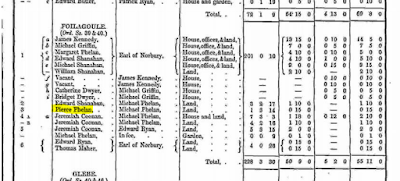DEATH: 27 Feb 1927 • Detroit, Wayne, Michigan
MARRIED: 9 Oct 1860 • John Hughes
Margaret Phelan was born on February 26, 1839 in Upperchurch, Tipperary, Ireland. Her parents were Pierce Phelan and Mary Dwyer who married in 1828 in Tipperary. She was their 7th child and 1st daughter.
Upperchurch is a village in County Tipperary. It is the ancestral home of those with the surnames O’Dwyer/Dwyer and O’Ryan/ Ryan. It belongs to the civil parish of Moyaliff and the Catholic Parish of Upperchurch-Drombane. The Phelan (O’Phelan, O’Phealin) name originated in Counties Waterford and Kilkenny.
Life in Mid 19th Century Ireland
 |
| County Tipperary |
Life in Mid 19th Century Ireland
The majority of the people of Ireland were Catholic peasants; they were very poor and had virtually no political power. It was difficult for a family to generate income on tiny farms after feeding their family. As a result, the rural population of Ireland, which was the large majority of the population, lived in extreme poverty. 1853 land records for Pierce Phelan indicate he was a tenant of a Michael Phelan, who was probably a relative. Micheal Phelan also lived on the land, so he wasn't an absent landlord. Shortly after the Land Valuation, the Phelans migrated to Canada.
Cottages were built with local stone or turf and thatched with rush or straw. Many cottages did not have windows and chimneys. There was sometimes a hole in the roof to let out smoke. Pigs, poultry and other animals lived with the family, often sleeping in the same room. The houses could not be over a certain height or the rent was raised. The door could not be more than five foot eight inches high, so there was a step down into the kitchen to allow for extra space. Fireplaces were subject to a "Hearth Tax", so many families went without. In the cold and damp environment the only form of heat for cooking and warmth was a peat or "turf" fire.
Catholics had large families and children were baptized very soon after birth. The baptism generally occurred in a church and was performed by the parish priest. The child is generally named for a Saint or a family member who is gone. Generally there was a godfather and godmother.
Many rural Irish lived far from the parish church. A practice sprang up where the priest went to local villages to say mass and hear confessions. It was a day-long event with a gathering in the evening for tea, singing, story telling, music, step dancing. Called The Stations, this practice went on at least until the 1880s and later in some areas.
The belief in fairies, leprechauns, pookas, and banshees was common, even among the devoutly Catholic. Pilgrimages to holy wells were frequent. Fairies were generally considered malevolent, although they sometimes performed beneficial functions. The leprechaun was small mischievous male spirit. A pooka was a faire who generally took the form of a dark horse with yellow eyes and a long wild mane. The Banshees warned of approaching death with unearthly wails.
 |
| Upperchurch, Tipperary, Ireland |
The Great Hunger of 1845-1849
The potato famine affected all of Ireland. Rural areas suffered more than the towns and cities. A huge population increase between 1820-1841 put tremendous pressure on the subsistence farming of the times as land was divided into smaller and smaller plots.
The potato was the major food crop of the poor Irish because it was cheap, easy to plant, and grew well in the rocky soil. Everything was used: potato skins and surplus potatoes were fed to the pigs, and pig manure was used to fertilize the potato fields. The potatoes were seasoned with salt and eaten three times a day. The only other food was cabbage, fish, an occasional chicken, eggs and some dairy. The Irish dependence on the potato as their major food crop was the main reason for the devastation that occurred when the potato crop failed. As there was no national system of relief for the poor, over one million people died during the famine and over 90,000 people were evicted from their homes.
Children of Pierce Phelan (1798-1880) and Mary Dwyer (1804-1892)
- John (1829-1915)
- Terrance (1831-1840)
- James (1833-1825)
- Patrick (1834-1923)
- Michael (1835-1906)
- Jeremiah (1838-1911)
- Margaret (1842-1927) my great-grandmother and twin to Pierce
- Pierce (1842-1926)
- Bridget (1844-1916)
- Thomas (1846-1846)
- Thomas (1847-1896)
- Mary (1850-1896)
- Catherine 1854-born in French Canada
The Phelans leave Ireland for Canada
 |
| O'Dwyer Coat of Arms |
 |
| O'Phelan Coat of Arms |
 |
| Pierce Phelan grave marker |
 |
| Land record from Tipperary |

